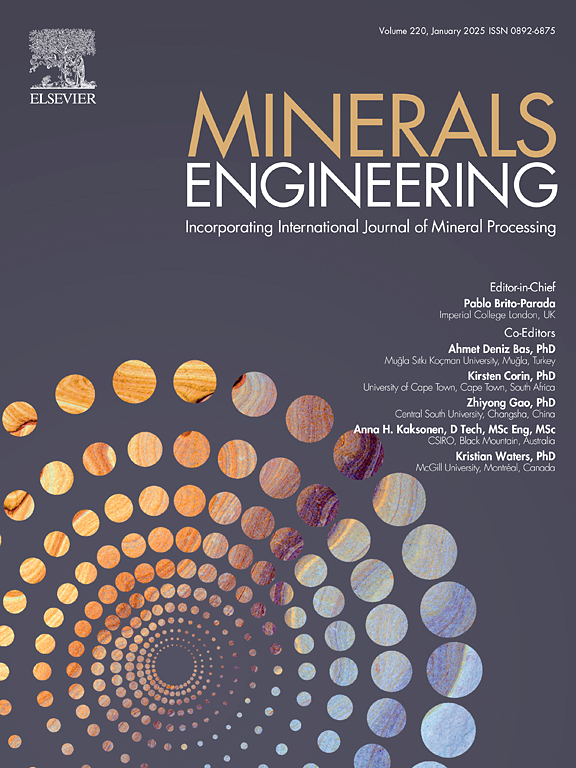Forms of rare earth loss and the function mechanism of acetic acid in the aluminum removal process of rare earth leaching liquor
IF 4.9
2区 工程技术
Q1 ENGINEERING, CHEMICAL
引用次数: 0
Abstract
The leaching liquor extracted from ion-adsorption type rare earth (RE) ores contains large amounts of aluminum (Al) ions. The neutralization-precipitation method for Al removal results in the loss of large amounts of RE, leading to the waste of RE resources. Preliminary research has shown that the introduction of acetic acid (HAc) during the Al removal process could effectively reduce RE loss. However, there has been no in-depth study on the forms of RE loss during the Al removal process with the neutralization-precipitation method and the function mechanism of HAc. In this paper, the yttrium element was used as a representation of RE for relevant research. It was found that the forms of RE loss mainly include adsorption loss and coprecipitation loss, and the addition of HAc can simultaneously reduce both types of loss. The addition of HAc can generate Y(Ac)2+ and Y(Ac)2+ complexes with Y3+, leading to an increase in the initial precipitation pH of yttrium hydroxide from 6.62 to 6.87, thereby reducing the coprecipitation loss of RE. Additionally, HAc was adsorbed on the aluminum hydroxide (Al(OH)3), which increased the surface potential and decreased the specific surface area of Al(OH)3, thus reducing the adsorption loss of RE. Finally, through precipitation experiments on a mixed solution of aluminum sulfate and yttrium sulfate, it was found that when the neutralization pH was 5.2, the percentage of yttrium lost decreased from 18.91 % to 12.66 % as the concentration of HAc was increased from 0 to 0.012 mol/L. The above function mechanism of HAc was further verified through XPS, SEM-EDS, and other tests on the precipitate.
稀土浸出液除铝过程中的稀土流失形式及醋酸的作用机理
从离子吸附型稀土(RE)矿石中提取的浸出液含有大量的铝(Al)离子。中和沉淀法脱铝会导致大量稀土流失,造成稀土资源的浪费。初步研究表明,在脱铝过程中引入醋酸(HAc)可有效减少可再生能源的损失。然而,对于中和沉淀法脱铝过程中 RE 的损耗形式以及 HAc 的作用机理还没有深入的研究。本文以钇元素作为 RE 的代表进行了相关研究。研究发现,RE 的损耗形式主要包括吸附损耗和共沉淀损耗,而添加 HAc 可同时减少这两种损耗。HAc的加入可生成Y(Ac)2+和Y(Ac)2+与Y3+的络合物,导致氢氧化钇的初始沉淀pH值从6.62升高到6.87,从而减少了RE的共沉淀损失。此外,HAc 被吸附在氢氧化铝(Al(OH)3)上,使氢氧化铝(Al(OH)3)的表面电位升高,比表面积降低,从而减少了 RE 的吸附损失。最后,通过对硫酸铝和硫酸钇的混合溶液进行沉淀实验发现,当中和 pH 值为 5.2 时,随着 HAc 浓度从 0 摩尔/升增加到 0.012 摩尔/升,钇的损失百分比从 18.91% 降低到 12.66%。通过对沉淀物进行 XPS、SEM-EDS 等测试,进一步验证了 HAc 的上述作用机理。
本文章由计算机程序翻译,如有差异,请以英文原文为准。
求助全文
约1分钟内获得全文
求助全文
来源期刊

Minerals Engineering
工程技术-工程:化工
CiteScore
8.70
自引率
18.80%
发文量
519
审稿时长
81 days
期刊介绍:
The purpose of the journal is to provide for the rapid publication of topical papers featuring the latest developments in the allied fields of mineral processing and extractive metallurgy. Its wide ranging coverage of research and practical (operating) topics includes physical separation methods, such as comminution, flotation concentration and dewatering, chemical methods such as bio-, hydro-, and electro-metallurgy, analytical techniques, process control, simulation and instrumentation, and mineralogical aspects of processing. Environmental issues, particularly those pertaining to sustainable development, will also be strongly covered.
 求助内容:
求助内容: 应助结果提醒方式:
应助结果提醒方式:


